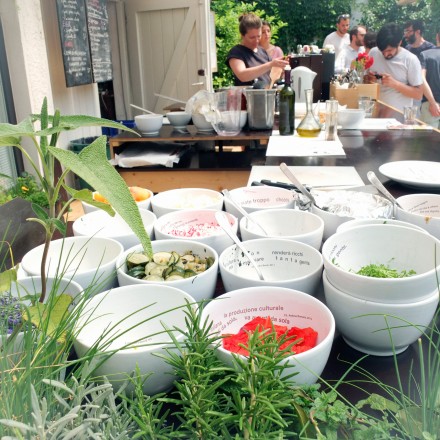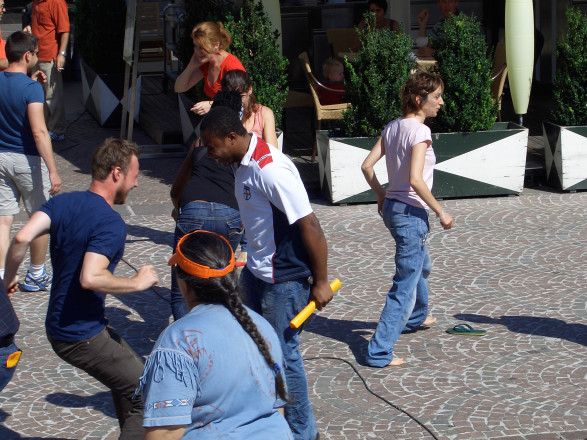Kritische Komplizenschaft / Critical Complicity
Complicity is the micro-political coalition that operates at these edges of established systems of order. In the shadowy zones of dubious alliances unfolds a critical potential, a multiplicity of subversive modes of production. The spectrum of entanglements in the art field is extensive; the abundance of ingestible positions forms the bases for tension-filled collaborations and multiplies the contradictions.
The aim of the project Kritische Komplizenschaft / Critical Complicity is a topology of the complicit. Three aspect which we consider central to alternative artistic practice define the conjunction of different perspectives: the intersections of macro- and micro communities and the moments of interdependency, the frictions of illegal/legal as well as affect and seduction and the field of tactical media. Each of these aspects shall be investigated in a separate phase of the project and in collaboration with different partners. Yet it is only in the intersection of these parameters where the complexity of critical complicity emerges.
It exposes the separating function of identitarian role play within the conventional art circuits – such as producer-recipient – as an ideological construction that blocks social energies just before their critical potentiality erupts. It is the deconstruction of the singular that ties the participants of Kritische Komplizenschaft/ Critical Complicity together. To oppose the current boom of participatory practice and to reactivate artistic collectivity beyond precarious altruism and “synergetic” co-authorship is one of the project’s core interests.
Lungomare, Frauenarchiv, Palais Pock, Casa Tabarelli
What will I not regret later?
Lungomare Bozen-Bolzano
With: Dexter Sinister, Olaf Nicolai, Tanja Ostojic, Anna Scalfi
Thu 25/11/2010, 7 p.m.
Lungomare, Via Rafensteinweg 12, Bozen/Bolzano
Presentation of the project with Lisa Mazza and Julia Moritz
FRAZIONI MULTIPLE I, Anna Scalfi — Installation
A conversation between: Gianfranco de Bertolini, Anna Scalfi, Cesare Pietroiusti
TRUE MIRROR MICROFICHE, Dexter Sinister — Installation
Fri 26/11/2010, 6 p.m.
Frauenarchiv/Archivio delle Donne, Pfarrplatz/Pz. Parrocchia 15, Bozen/Bolzano
WHAT WILL I NOT REGRET LATER? — Performance
Sat 27/11/2010, 6 p.m.
Palais Pock, Musterplatz/Pz. della Mostra 2, Bozen/Bolzano
QUESTIONNAIRE PROJECT, Tanja Ostojic — Performance
Sun 28/11/2010, 12.30 p.m.
Casa Tabarelli, Schöne Aussicht/Strada Belvedere 13, Girlan/Cornaiano
CHARTREUSE JEUNE — arrangement by Olaf Nicolai
Contributions: Julieta Aranda, John Armleder, Elisabetta Benassi, Karla Black, Monica Bonvicini, Thomas Demand, Jason Dodge, Dora García, Piero Golia, Douglas Gordon, Karl Holmqvist, Carsten Höller, Jonathan Monk, Carsten Nicolai, Mai-Thu Perret, Anri Sala, Kelly Schacht, Tilo Schulz
Further project partners:
Kunsthalle Exnergasse, Wien – Exhibition 11/11 – 18/12/2010
Galerija Skuc, Ljubljana – Platform 27/01 – 30/01/2011
Schlebrügge.Editor – Publication
As part of the project Kritische Komplizenschaft / Critical Complicity has been realized a publication in collaboration with Lungomare Bozen-Bolzano.
Editors: Lisa Mazza, Julia Moritz
With contributions by: Hans Haacke, Olaf Nicolai, Ahmet Ögüt, Tanja Ostojic, Dexter Sinister, Barbara Steiner, Gesa Ziemer, etc.
Publisher: Schlebrügge.Editor
ISBN 978-3-85160-186-2
Kritische Komplizenschaft / Critical Complicity on issuu.com
Order the book here: info@lungomare.org
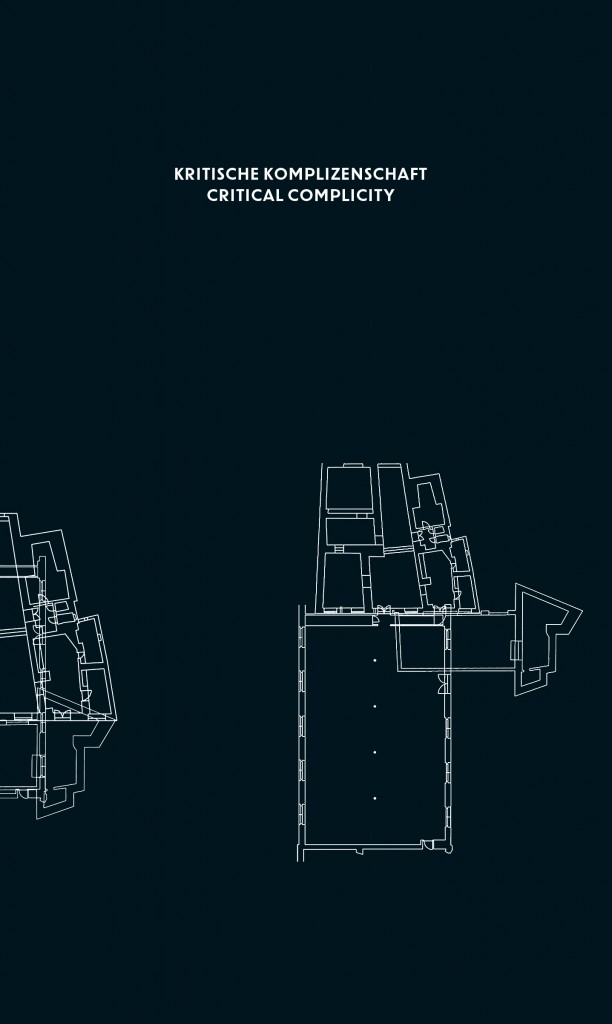
Anna Scalfi, installation
A conversation between Gianfranco De Bertolini, Anna Scalfi, Cesare Pietroiusti, Angelika Burtscher and Daniele Lupo
“Frazioni Multiple” is a series of interventions, where the approach of distributing the value of an artistic work into editions becomes the content of the work itself. The modality usually applied when selling works of art becomes the starting point for a series of works, which are composed of parts of a whole and not of editions of the same type. The starting point is a single piece, which is broken down into elements, which can be sold individually. At the moment of purchase, the buyer is obliged by contract to provide the items acquired singularly, on the occasion of a possible exhibition, so that the work can be shown as a whole. In this way, the owners of each single piece are in a property relationship with one another, which does not refer exclusively to the aesthetic object, but also contractually binds all future owners to one another. The formal component manifests itself next to the selected, shared object, also within the terms of the contract, which defines the relationship between the individual parts, and thereby retains the idea of the total artwork. The sales process of the work is undertaken in a manner that brings these dynamics to light and reflects on the modality of the sale of an artwork and the justification of its pricing and market value.
Starting from Anna Scalfi’s “Frazione Multiple I”, the artist will be in conversation with Cesare Pietroiusti, artist and gallery owner who exhibits Anna Scalfi’s work, the collector and lawyer Giancarlo de Bertolini and the founding directors of Lungomare, Angelika Burtscher and Daniele Lupo. The question of authorship, the mechanisms behind the sale of works of art and the related normative agreements, but also the value definition of a work of art and the question of the divisibility of the value of a work of art will be investigated.
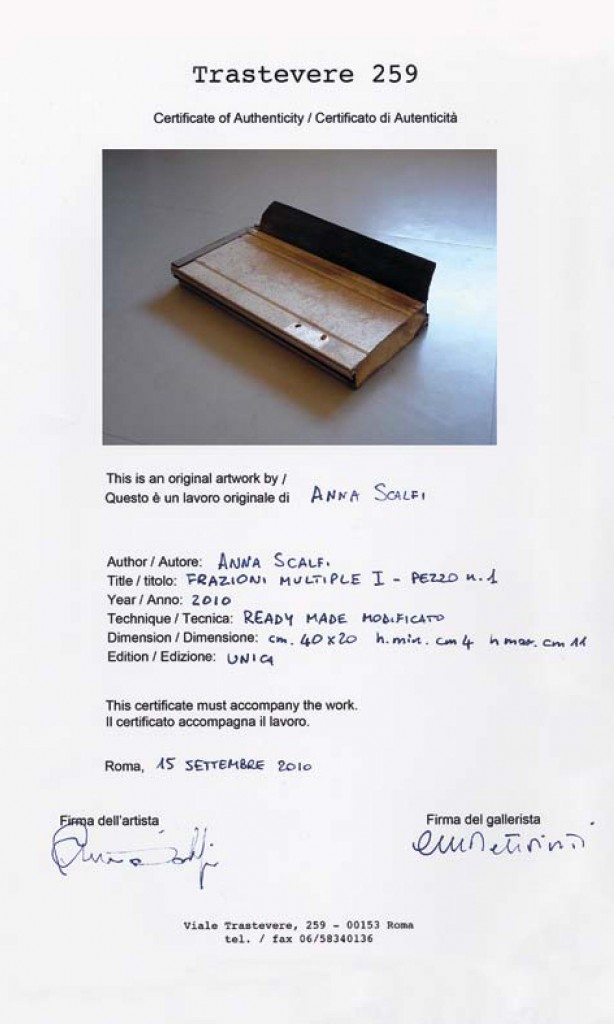
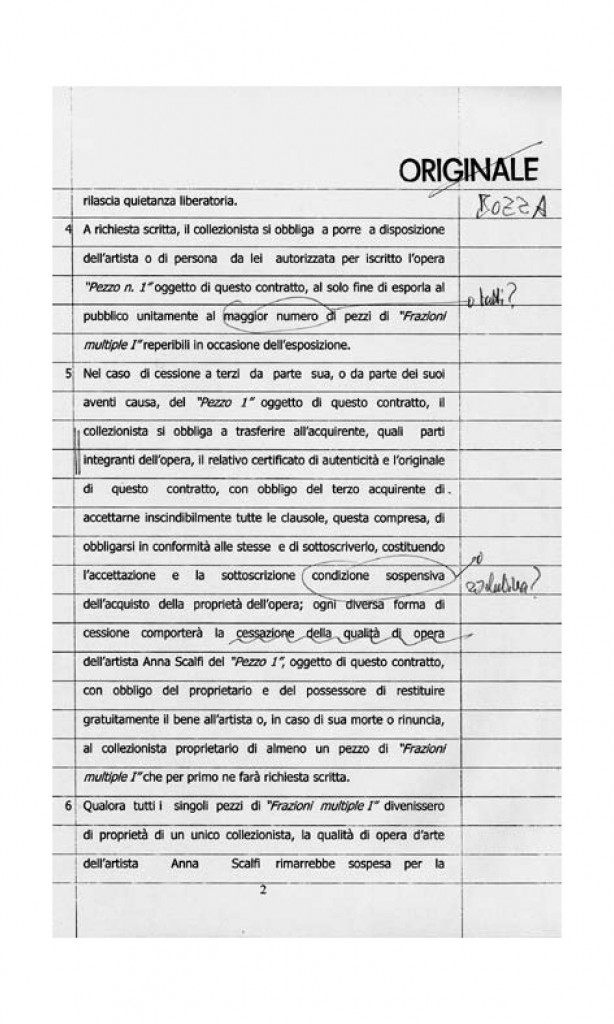
Talk: Frazioni Multiple I, 25/11/2010
Dexter Sinister, installation
Dexter Sinister’s interest in focusing on the theme of self-publishing started from her work as a designer of printed artwork, and led to the publication of the magazine dot dot dot, of which the publication events soon became an independent series of performance actions. The “True Mirror Microfiche” (2008) installation, which was presented in Bolzano is likewise a loose collection of so-called “press releases” and a subsequent performance reading, which among others, was presented at the Institute for Contemporary Arts in London in 2009. Both formats criticize, for example, the metropolitan media, speed, novelty value etc. However, “True Mirror Microfiche” is by no means just a book or a performance; the work cleverly puts in the limelight that form of truth, which is created by the distribution itself. So, in addition to the actual microfiche, the specially crafted script and the cinematic “trailer” of this non-cinematic documented event will be shown. The “review” of the work is something that emerges automatically from a predominant interest in rhetoric, distribution etc. Each “critical potential” is activated by how it lives on in others minds (or not) and in which other forms it appears (or not). The problem is that this is what cannot be measured.
Performance
Friday, 26.11.2010, 6pm, Frauenarchiv, Pfarrplatz 15, Bozen/Bolzano
A. I do not appear as an author of works and would like to discuss with you how we should deal with this in the following. It would mean that I prefer not to be named in any publicity materials etc.; but would rather try to find a solution with you about how one can describe what will come instead. I have decided this because it gives me the opportunity to pursue some of my thoughts about the production of situations that are not so much linked to the ideas of a single person, but ideas, individual characters and the potential of an event / atmosphere to capture the moment, in which ideas emerge, that cannot be attributed to a particular person nor be based on a consistent speaker’s perspective. However, the encounter as such offers the chance to find out where exactly one situates oneself in relation to others at a given time.
B. I have the feeling that these things have a lot to do with each other, because this moment of fuzziness of individual authorship repeatedly appears in conditions or actions, particularly in those related to normative (legal / moral) conventions. We demonstrate this in our concept and want to elaborate further using theoretical texts. What do you think about that?
C. It could be a problem that people do not want to approach a person who does not reveal their name. It might seem as though you would be exerting your position of privilege, that is only available to you as an invited person, and that, within this context assumes a certain power of control.
Tanja Ostojic, performance incl. screening
Saturday, 27.11.2010, 6pm, Palais Pock, Musterplatz 2, Bozen/Bolzano
“Questionnaire Project” (2006-2010) is a long-term designed research project presented as an Auction Performance within the context of „Kritische Komplizenschaft / Critical Complicity“ in the form of an “Art Bond” by Tanja Ostojic on behalf of the Art & Economics Group. The “Questionnaire Project” is based on questionnaires that were sent in 2006 and 2007 to institutions and exhibition projects, to which the artist was invited. The response and submission of these questionnaires and the resulting disclosure of the financial structure of the project were essential in order for the artist to decide if she wanted to collaborate with the institution within the context of the proposed project. Many institutions do not release their project budgets as a matter of principle, and consequently construed this artistic research as an insult or endlessly delayed responding to the questionnaire. The result of this approach was that the number of exhibitions in which Tanja Ostojic participated in 2006-2007, steadily decreased and additionally negatively influenced her ranking under www.artfacts.net. The Art & Economics Group, founded in Berlin by Tanja Ostojic, David Rych and Dmytri Kleiner in 2007, examines the intersection of art and political economy. In the first two years, there were regular quarterly meetings of the Board of the Art & Economics Group held in Berlin. Topics are, amongst others, the political economy as an artistic theme, the economies of artistic production or economic activity as action-based arts practice.
In addition to the auction of “Art Bonds” is the projection of the film “The Great Contemporary Art Bubble” (60 minutes, English language). The film by the British art critic and filmmaker Ben Lewis examines the rise and fall of the arts market in 2008 and 2009. A discussion with the audience will follow the film.
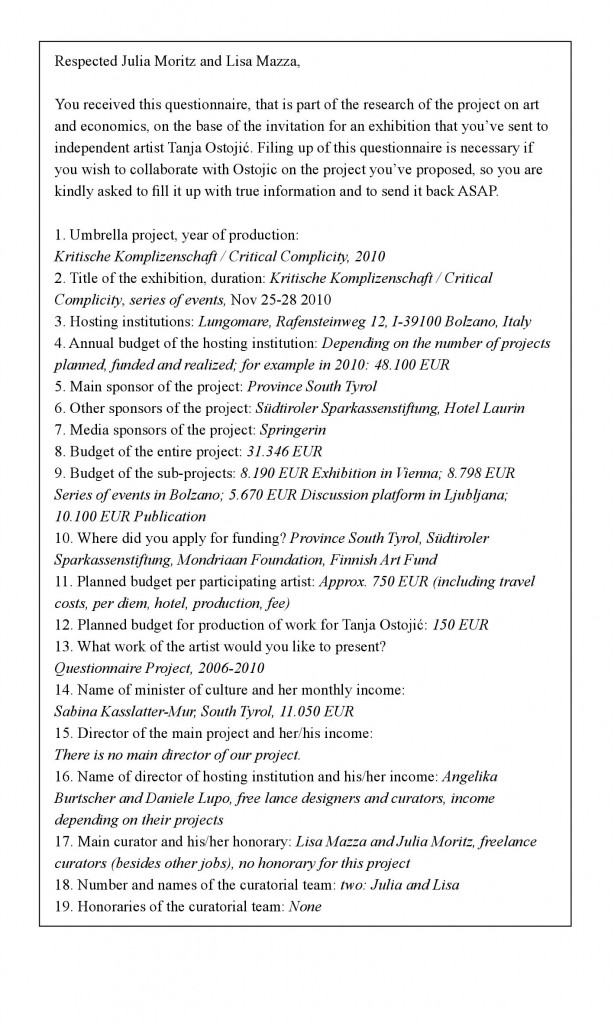
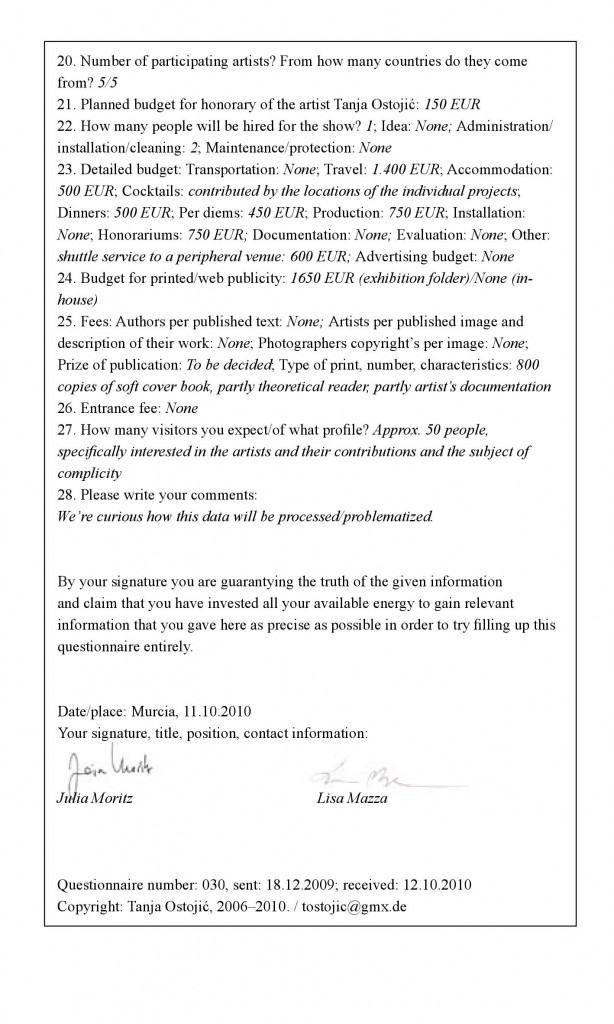
An arrangement by Olaf Nicolai
Sunday, 28/11/2010, 12.30 – 3pm, Casa Tabarelli, Schöne Aussicht 13, Girlan/Cornaiano
With contributions from Julieta Aranda, John Armleder, Elisabetta Benassi, Karla Black, Monica Bonvicini, Thomas Demand, Jason Dodge, Dora García, Piero Golia, Douglas Gordon, Karl Holmqvist, Carsten Höller, Jonathan Monk, Carsten Nicolai, Mai-Thu Perret, Anri Sala, Kelly Schacht and Tilo Schulz
“The world wishes to be deceived, certainly. Yet if you don’t, it will be seriously angry.” These are the last sentences of Walter Serner’s manifesto “Letzte Lockerung” (“Last Loosening”), first published 90 years ago and accompanied by the following subtitle in its final version in 1927: “A Handbook for the Con Man”. At a time when Dadaism had arrived on the art market, Serner’s text performs the valediction and parting from this movement, in order to propagate subtle speculation, devoid of illusions, as a strategy of self-assertion from then on. At the outset, he suggests that each reader consume a heavy meal of several courses before reading, served with the digestif Chartreuse jaune. This forms the initial reference for Chartreuse jeune, the title heading Olaf Nicolai’s intervention at the Casa Tabarelli, a private residential building in the vicinity of Bolzano designed by Carlo Scarpa in 1967 which has remained relatively unknown until today. Nicolai has invited seventeen artists to create works specifically for this location and occasion which he in turn will implement according to their instructions. The range of the repertoire spans from a subtle gesture over the installation of objects to performance. The composition of Chartreuse jeune thereby creates a camouflage that transforms the history and atmosphere of the building, whereby the exact line of the border between pre-existing interior and intervention remains unclear to the visitor.
In this context, Nicolai’s work particularly emphasises the animation of the “critical complicity” as a strategy of confusion and attraction of attention focused in this case on the Casa Tabarelli—an architecturally highly significant building that to this day is not treated as a cultural heritage worth conservation by the public authorities.
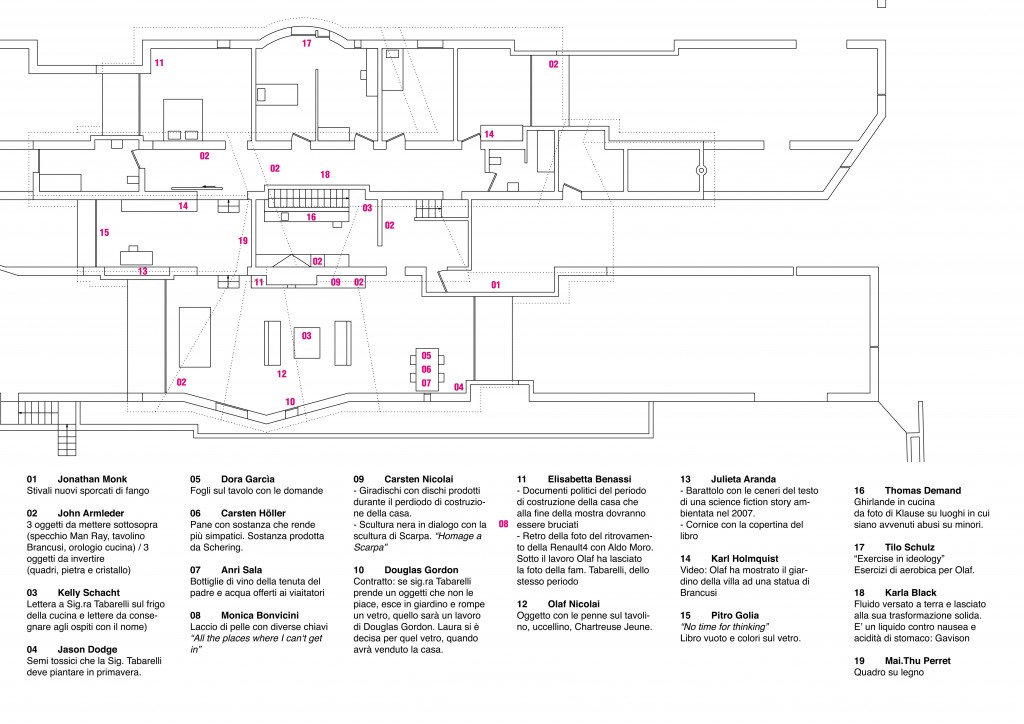
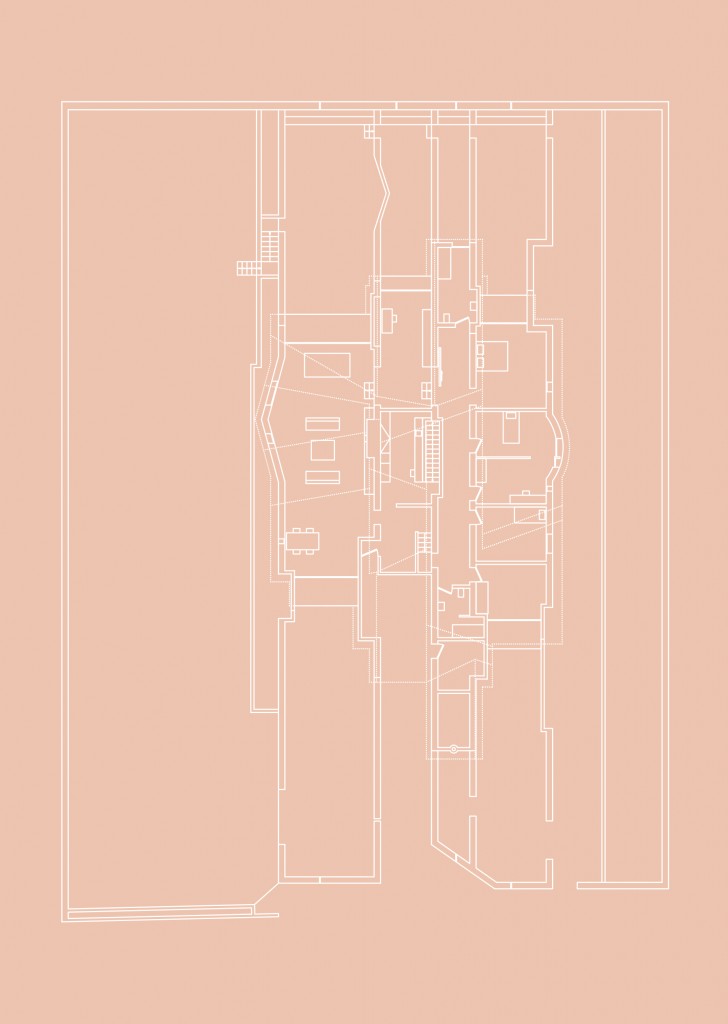
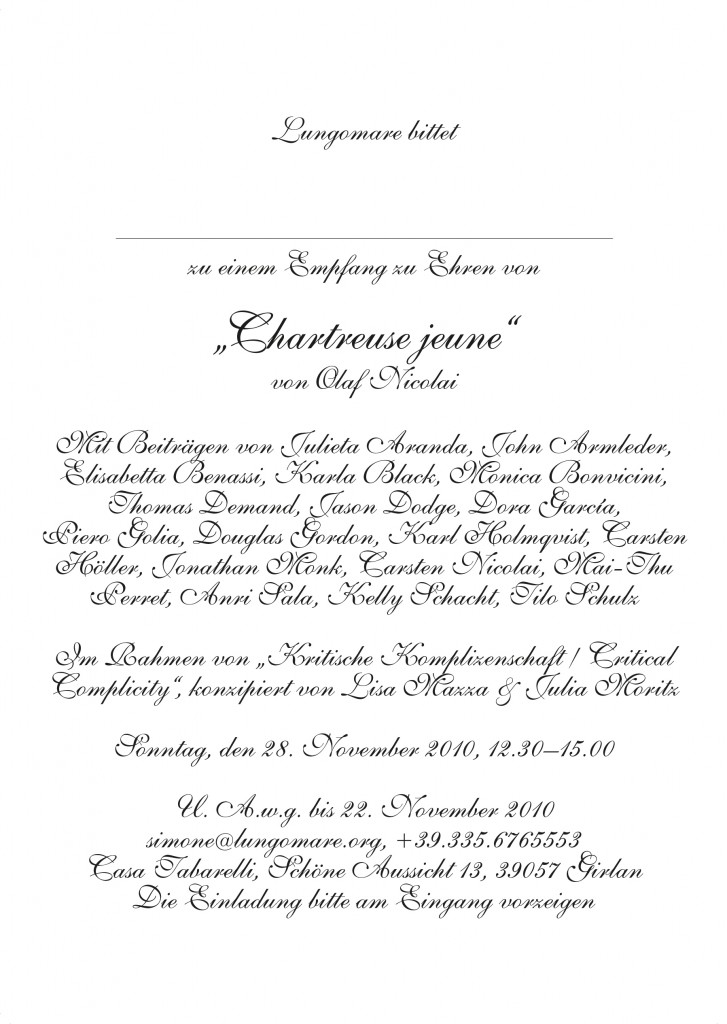
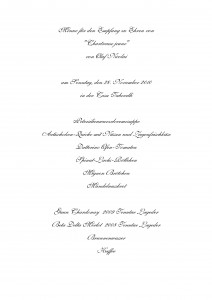
Autonomous Province of Bolzano-South Tyrol, Cultures Departments
Fondazione Cassa di Risparmio
Parkhotel Laurin
Cantina Alois Lageder
Partner:
Heinz Peter Hager, Frauenarchiv Bozen/Archivio storico delle donne, Laura Tabarelli
What´s on
EXHIBITION :: Binta Diaw :: Collective Practices – A Living Experience of Feeling ListenedAbout Lungomare
Lungomare, a cultural association founded in Bolzano in 2003, was created from the desire and necessity to open a space in which to share differences, experiences, opinions and desires, a space in which to make the link between cultural production and the political and social dimension. Lungomare undertakes projects that investigate and test possible relationships between design, architecture, urban planning, art and theory, the results of which are presented in different formats: public discussions, conferences, publications, exhibitions and interventions in public spaces. All these formats are characterised by the intention to interact with cultural and socio-political processes relating to the region in which Lungomare is located.
Currently Lungomare’s activities focus on long-term residency projects, a format whereby Lungomare invites guests to engage and interact within the context of South Tyrol. Lungomare’s activities are based on three principles: specific attention to the context in which the association’s projects are undertaken, the transdisciplinary approach that distinguishes these projects, and reflection on the role of Lungomare as a cultural institution in connection with the region in which it operates.
Territory
Lungomare is located at the edge of Bolzano, the capital of South Tyrol, and relates to the context in which it operates, attempting to highlight the dynamics of change. Large urbanized areas alternate with broad areas of intensive cultivation and yet others of picturesque landscape, all of which penetrate the centre of the city. The city is surrounded by mountains and this is one of the reasons why the tourism industry has become a driving force in this locality. The demographic structure of the city has been characterized for a long time by the coexistence of two populations, those speaking German and those speaking Italian. However, the social and demographic composition of Alto Adige Südtirol is changing. Migrants, including those from non-European countries are making their way to the area to settle, whilst others, including political refugees, are flowing through the region.

